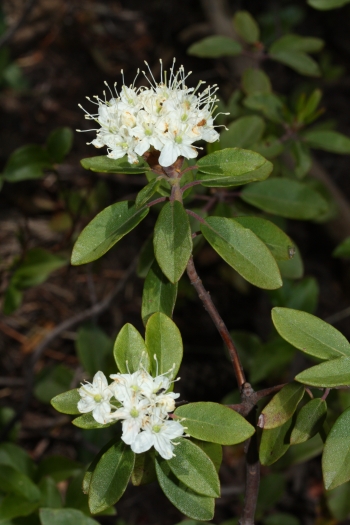Western Labrador Tea
(Rhododendron neoglandulosum)
Western Labrador Tea (Rhododendron neoglandulosum)
/
/

Walter Siegmund (talk)
CC BY-SA 3.0
Image By:
Walter Siegmund (talk)
Recorded By:
Copyright:
CC BY-SA 3.0
Copyright Notice:
Photo by: Walter Siegmund (talk) | License Type: CC BY-SA 3.0 | License URL: https://creativecommons.org/licenses/by-sa/2.0 | Uploader: Wsiegmund | Publisher: Wikimedia Commons |


Estimated Native Range
Summary
Rhododendron neoglandulosum, commonly known as Western Labrador Tea, is an evergreen shrub native to bogs, wet coniferous forests, and muskegs across the western United States and western Canada. It typically grows up to 2 meters (6 feet 7 inches) tall and spreads via underground rhizomes. The plant features ovate to lanceolate leaves that are fragrant when crushed and white to cream flowers that are borne in clusters of 10 to 35, blooming in late spring to early summer. The flowers are modest in appearance but can add a subtle charm to boggy or wetland garden areas.
Western Labrador Tea is valued for its fragrant foliage and its adaptability to wet, acidic soils, making it suitable for bog gardens and naturalized areas. It is also used for its medicinal properties, as the leaves can be made into a tea with astringent, diaphoretic, diuretic, and laxative effects. However, caution is advised as the plant can be toxic if the tea is steeped excessively. Additionally, the scent of the leaves is beneficial for repelling insects and rodents. Cultivation requires full sun to partial shade, consistent moisture, and acidic soils with medium to slow drainage. While generally low-maintenance, it can be susceptible to root rot in poorly drained soils and may be affected by pests such as lace bugs and weevils.CC BY-SA 4.0
Western Labrador Tea is valued for its fragrant foliage and its adaptability to wet, acidic soils, making it suitable for bog gardens and naturalized areas. It is also used for its medicinal properties, as the leaves can be made into a tea with astringent, diaphoretic, diuretic, and laxative effects. However, caution is advised as the plant can be toxic if the tea is steeped excessively. Additionally, the scent of the leaves is beneficial for repelling insects and rodents. Cultivation requires full sun to partial shade, consistent moisture, and acidic soils with medium to slow drainage. While generally low-maintenance, it can be susceptible to root rot in poorly drained soils and may be affected by pests such as lace bugs and weevils.CC BY-SA 4.0
Plant Description
- Plant Type: Shrub
- Height: 1-4 feet
- Width: 3-4 feet
- Growth Rate: Slow
- Flower Color: White
- Flowering Season: Spring
- Leaf Retention: Evergreen
Growth Requirements
- Sun: Full Sun, Part Shade
- Water: Medium
- Drainage: Medium, Slow
Common Uses
Bee Garden, Bird Garden, Butterfly Garden, Hummingbird Garden, Low Maintenance, Rabbit Resistant, Showy Flowers
Natural Habitat
Bogs, wet coniferous forests, and muskegs
Other Names
Common Names: Swamp Tea, Muskeg Tea, Glandular Labrador Tea, Rhododendron Glanduleux
Scientific Names: , Ledum glandulosum, Rhododendron neoglandulosum, Ledum glandulosum var. glandulosum, Ledum glandulosum var. californicum, Ledum californicum, Ledum glandulosum subsp. glandulosum, Ledum groenlandicum subsp. glandulosum,
GBIF Accepted Name: Rhododendron neoglandulosum Harmaja